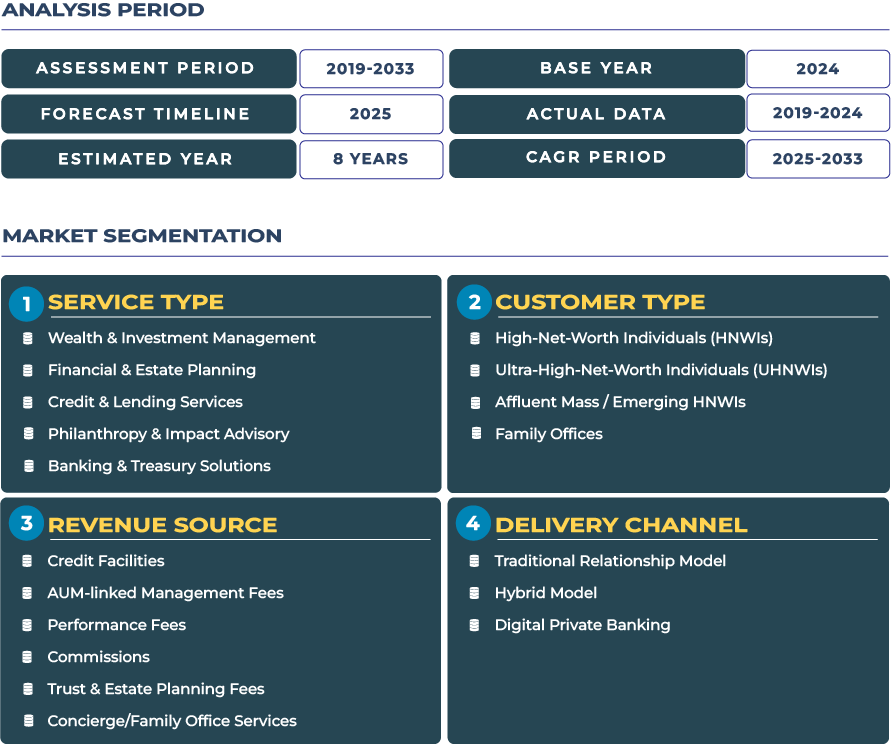Market Outlook: Strategic Growth Pathways for the UK Private Banking Market in 2025-2033
The UK private banking market outlook is defined by structured growth and strategic reinvention rather than rapid scale. With a market size rise from USD 66.0 billion in 2025 to USD 77.7 billion by 2033, at a CAGR of 2.1%, it is clear that the winning firms will deepen value per client, broaden service envelopes and execute cross-service integration rather than rely solely on incrementally larger asset flows. The affluent-client base continues to evolve-inheritance-driven wealth transfer, entrepreneurial exits, and global mobility are increasingly shaping demand. For UK private banks, expansion now hinges on delivering integrated liquidity, cross-border advisory, tech-enabled access and embedded banking-investment-treasury frameworks.
Note:* The market size refers to the total revenue generated by banks through various services.
Economic and regulatory headwinds add nuance to this outlook. Persistent inflation, elevated interest rates, real-estate market softness and heightened tax-policy uncertainty-particularly around domicile status-pose pressure to client asset growth and service margin. At the same time, the UK remains a global wealth-management hub thanks to its legal infrastructure, language advantages and capital-markets sophistication. Success will depend on firms pivoting toward platform-centric models, embedding payments/t-reasury flows into wealth doors, and delivering advisory-rich investment and insurance-modalities. The path to capture that 2.1% CAGR is less about asset expansion and more about service depth, operational efficiency and thematic differentiation.
Drivers & Restraints: Key Catalysts and Barriers Reshaping the UK Private Banking Sector
Growth-Drivers Powering the UK Private Banking Market
One of the most significant drivers is the impending inter-generational wealth transfer in the UK-NatWest Group estimates baby-boomer wealth hand-downs at approximately £1.2 trillion in the coming decade, creating a sizeable next-gen affluent segment seeking holistic private banking services. The digital acceleration of wealth platforms, rise of alternative investments, and demand for integrated advice (credit + investment + liquidity) also fuel growth. Moreover, the UK’s mature ecosystem-regulatory robustness, capital-markets access, legal-trust services-continues to attract global and mobile high-net-worth individuals, reinforcing the UK’s positioning as a private banking hub.
Restraints and Growth-Headwinds in The UK Private Banking Market
Despite structural potential, key barriers remain. The UK is experiencing a wealth-migration trend: up to 16,500 high-net-worth individuals (HNWIs) are expected to exit in 2025, carrying about USD 92 billion in investable assets abroad. This tax- and policy-driven outflow undermines client-base expansion and asset stability. In addition, margin compression continues to challenge profit pools-historical studies show UK wealth/privately-banked asset bases facing operating cost inflation and deteriorating cost/income ratios. Regulatory complexity, shifts in domicile regimes and heightened reporting burdens increase cost-to-serve for private banks.
Trends & Opportunities: Emerging Dynamics Transforming the UK Private Banking Value Chain
Key Trends Reshaping The UK Private Banking Landscape
Digital-wealth transformation is accelerating: clients expect unified platforms that combine investment services, digital onboarding, real-time payments and treasury-linked liquidity-all within one interface. ESG and sustainability mandates are gaining ground as high-net-worth clients in the UK demand impact-aligned portfolios and sustainability-linked banking/insurance offerings. Another trend is the growth of next-gen wealth-millennials and Gen Z inheritors-with different preferences: mobile-first, values-driven and alternative-asset oriented, requiring private banks to dual-engine their propositions (traditional UHNW + next-gen affluent).
Opportunity Levers For UK Private Banking Firms
Private banks that embed payments and treasury features within wealth services-such as real-time cross-border transfers, liquidity warehousing and securities-based lending-can deepen client engagement and expand wallet share. The London regional wealth hub, with its network of family-offices, global corporate executives and asset owners, remains a strategic growth zone. Collaboration with fintechs (digital-payments, robo-advisory, embedded insurance) offers efficient growth pathways without heavy CapEx. Furthermore, next-gen affluent clients offer a launch-pad for future revenue engines-firms who build thematic alternative-investment platforms, digital advisory and legacy-planning services early will capture incremental share as wealth migrates between generations.
Competitive Landscape: Strategic Moves and Market Differentiation in UK Private Banking
The competitive terrain in the UK private banking market reflects strategic repositioning. One notable development: HSBC relaunched its “Premier” wealth banking brand in the UK in November 2024, targeting mass-affluent clients with £100K–£2 M investable assets, signalling a shift toward broadened wealth-platform models beyond traditional UHNW segments. This illustrates how domestic and global banks are dynamically targeting layered client segments rather than single wealth bands.







